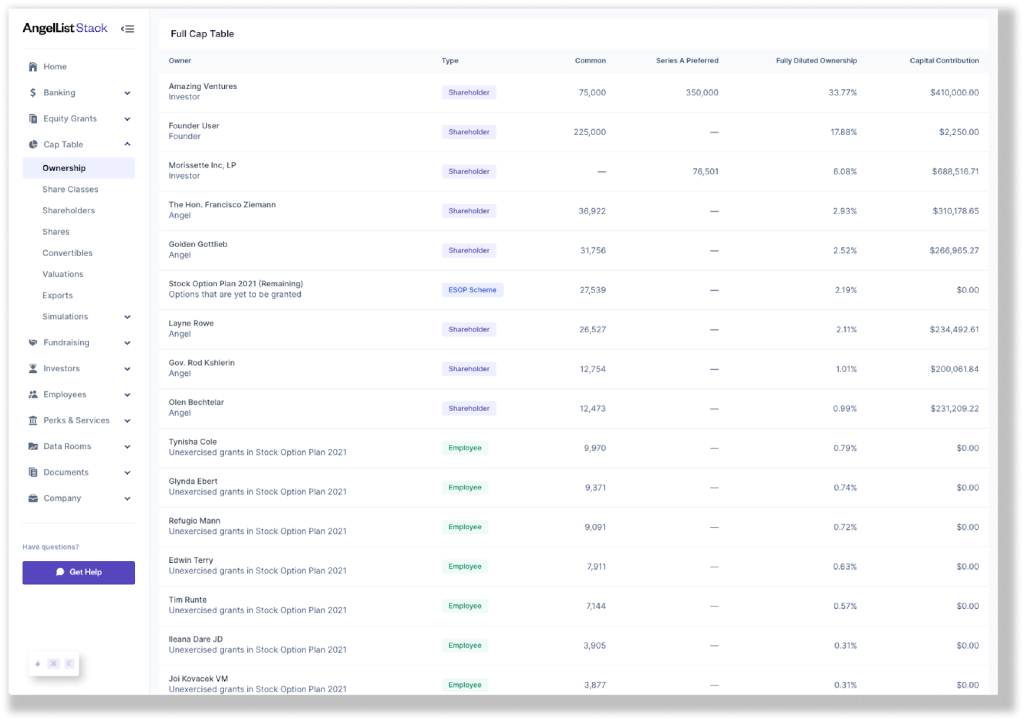Cap Tables : What Startups Founders Need to Know About Equity Ownership When Raising Investor Capital
Are you a startup founder that is pitching investors for a seed round or Series A investment? It can be nerve-racking enough just finding and pitching the right investors. Let alone getting caught up to speed on all of the technicalities of the investment capital — how you should calculate your valuation, what your term sheet actually says, and what a cap table is.
What is a Capitalization Table?
Cap tables, (which are short for) capitalization tables, are critical for startup founders to understand when fundraising with investors. A cap table is a document that outlines the ownership structure of a company, including the distribution of shares, the value of those shares, and who owns them.
Angelist states that a cap table lists out all of a company’s securities—such as common shares and preferred shares, options, SAFEs, convertible notes, equity ownership grants, and warrants. It also shows how much of each security type each investor owns, the value of their respective stakes, and their current ownership percentage.
The cap table is a key due diligence item because it reveals how every stakeholder is impacted by a fundraising round.
In other words, a cap table is a comprehensive listing of what an investor would want to know about a company’s ownership.
An article in Angelist explains that while there is no set format for a cap table, every cap table should contain the following details:
- Authorized shares
- Outstanding shares
- Unissued shares
- Shares reserved for stock options
- Valuation details of the last priced round (including pre-money valuation, amount of new equity raised, per-share price, and number of shares)
- Complete list of shareholders (including type of shares they own, total number of shares, and percentage ownership stake)
(image credit: Angelist)
An article published by HydePark Angels stated that all of the key terms on a cap-table build from one another and are driven primarily from the term sheet discussions. But to sum up, you’ll be using all of the below formulas.
Post-Money Valuation = Pre-Money Valuation + Total Investment Amount
Price-Per-Share = Pre-Money Valuation / Pre-Money Shares
Post-Money Shares = Post Money Valuation/ Price-Per-Share
Investor Percent Ownership = Investor Shares / Post-Money Shares
Pro-Forma Capitalization Tables
During financing discussions, the parties usually prepare a pro-forma capitalization table. This is a version of the cap table that shows the updated company ownership after a financing round closes. It allows the parties to model out, exactly how the company’s ownership will change as a result of the financing round.
There is no set format for a pro-forma capitalization table. Here’s an example of what one might look like:

The key differences between pro-forma capitalization tables and “regular” cap tables are:
- The pro-forma cap table shows how the cap table would change should the financing round go through.
- The pro-forma cap table must account for potential conversions of convertible debt or SAFEs (if the financing round triggers a conversion).
- The pro-forma cap table may change multiple times as investors and founders negotiate the details of the round.
Here are a few key things that startup founders should keep in mind when working with cap tables:
- Understand the impact of funding rounds: Every time a startup raises funding, the cap table will change. Founders need to understand how each round of funding affects the ownership structure of the company and the dilution of their own ownership.
- Cap tables are critical documents: that help both founders and investors make more informed decisions regarding the company.
- Keep accurate records: It’s essential to keep accurate and up-to-date records of all share issuances and transfers. This will help ensure that the cap table is always accurate and that there are no discrepancies.
- Be mindful of equity compensation: Founders should consider how equity compensation, such as stock options, can affect the cap table. Offering equity compensation can be a useful tool for attracting and retaining talent, but it will also dilute existing shareholders.
- Consider the long-term impact: Founders should think about the long-term impact of the cap table on the company. A well-managed cap table can help attract investors, while a poorly managed one can turn them off.
- Work with a lawyer: Finally, it’s essential to work with a lawyer who can help you navigate the complexities of cap tables and ensure that all legal requirements are met. A good lawyer can help you avoid common mistakes and ensure that the cap table is set up correctly from the start.
Why does my startup need a cap table?
Cap tables are important because they tell you who owns how much of your company.
This can have an influence on things such as:
- how do you price future fundraising rounds
- dilution of your ownership percentage
- to figure out who needs to sign off on major company decisions
It helps you track the value of equity and debt investments so that you can stay up-to-date on the financial status of your business. It also can help you manage company stock options and how much employees can be granted from the stock pool.
It also can pinpoint future dilution. The Angelist article points out that seeing lots of convertible debt or SAFEs on the cap table could be a sign that an investor’s holdings could be diluted, potentially significantly, in the future.
An article in Carta, cp table management software company states that “accurate cap tables also play a major role in due diligence for potential investors or venture capitalists who are considering investing in your startup.” Meaning a well-maintained cap table can be crucial in any audits and future financing rounds.
Gain a fuller picture of the future
An article published in Hubspot on the subject suggests that it can help with term sheet negotiations with potential investors. Getting a clear snapshot of your company’s ownership structure also helps you run a what-if analysis on a financing round. You can look at what happens to your ownership stake and company control at different valuation levels and consider other factors, like the impact of issuing new options at different stages.
Scenario modeling tools such as Equity LTSE allow founders to model the impact of financing rounds, option pool sizings, liquidation preferences, deal terms, SAFE conversions, and much more—why brace for impact when you can sidestep it? And help see how financial instruments—even convertible instruments with unique conditions—stack together and convert across a range of priced round valuations and deal terms.
Reasons why Cap Tables can be more complex after each funding round
As you continue raising capital and involving more and more investors, your cap table may start becoming messier and harder to quickly understand. While cap tables often start out simple, they tend to become more complex as more rounds of financing are completed. The Angelist article points out some of the reasons that make cap tables’ become more complex over time:
- Different investors may have different rights and privileges. The same investment vehicle—whether preferred shares, SAFEs, or convertible debt—can have different privileges, such as different liquidation preferences, anti-dilution provisions, valuation caps, or discount rates. All these must be accounted for in the cap table.
- Anti-dilution protection for past investors could be triggered. For instance, if there is a down round, previous investors’ anti-dilution provisions may be triggered.
- Bridge rounds or follow-on rounds may be conducted with convertible debt. Startups may raise a bridge round or follow-on round using convertible debt—which would add to the cap table’s complexity as the conversion price for those instruments may not be known until the next funding round.
- The employee share option pool may have to be increased. As the startup grows, the employee share option pool may have to grow as well. Further, new employees will likely have options granted at different strike prices than previous hires.
- Stock options and warrants may be exercised or canceled. When employees exercise their options and convert them to shares, they will then be added directly to the cap table as shareholders. Employees leaving before their options are vested will also necessitate changes to the cap table.
- Shares may be transferred to other entities. For example, a founder may transfer their shares from their personal ownership to a trust.
Conclusion
A cap table is a guiding source of truth for your business, giving you a snapshot of ownership stake, stock options, and who should be involved in critical business decisions. Overall, understanding cap tables is critical for startup founders who are fundraising with investors. By keeping these tips in mind and working with experienced advisors, founders can ensure that their cap table is set up correctly and can help them achieve their goals.











